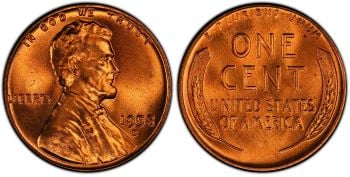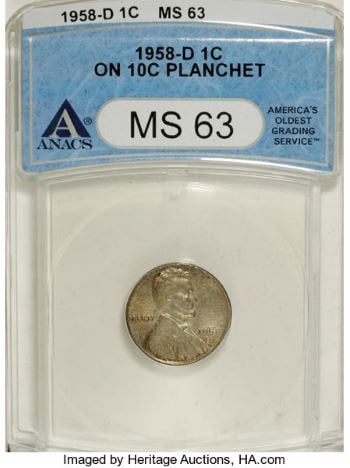Ed. note: This article is periodically updated to reflect the current price of most valuable coins.
In Coleccionistas de Monedas, we fight against the misinformation surrounding the world of coins on the Internet. For this reason, our articles are entirely written by people, not AI or other automated systems. Additionally, we link to all sources and references for coin prices, with the goal of providing you with real, updated, and reliable information.
How do we verify coin prices and values?
At Coleccionistas de Monedas, we are committed to providing accurate, trustworthy, and well-sourced numismatic information. We understand that articles about coin values can influence important financial decisions, which is why we apply a clear and rigorous methodology to estimate prices.
Sources used
- PCGS Price Guide: The official pricing guide from the Professional Coin Grading Service.
- NGC Price Guide: Updated valuation system from the Numismatic Guaranty Company.
- Heritage Auctions: Database of real auction sale prices.
- Red Book: Printed guidebook with historical pricing by grade.
- eBay Sold Listings: Only completed sales are considered, not asking prices.
Validation process
- Price review by condition grade using standard scales (MS, AU, XF, VF).
- Verification of varieties and errors through multiple data sources.
- Expert consultation when prices significantly deviate from the norm.
- Regular updates to reflect current market trends.
Important disclaimer
The values presented in this article are for reference purposes only. Final coin prices can vary significantly depending on authenticity, grade, and selling context. We strongly recommend having your coin certified by a professional service such as PCGS or NGC before selling or purchasing it as an investment.
The 1958 D pennies are among the lowest face value coins in the United States. However, as is often the case, certain errors and variations in the design can increase their retail value enormously.
Their high issuance, as well as their large circulation in common spending, make these coins widely collected, from children to veteran collectors.
The downside of this factor of abundance and common use, is that for that very reason they are usually found in very poor condition, and it is the pennies with good preservation that greatly increase the value.
How much is a 1958 Wheat Penny D worth?
Coleccionistasdemonedas.com estimates the 1958d wheat penny value to be:
| 1958 D Wheat penny value chart | ||||||||
| 1958 D wheat penny | MS60 | MS61 | MS62 | MS63 | MS64 | MS65 | MS66 | MS67 |
| Value | $2 | $2 | $3 | $4-5 | $7-8 | $15-18 | $22-60 | $275-3,360 |
The 1958 Wheat penny that sold for the highest price was a specimen of PCGS MS67+RD, which achieved a price of $3,360 at Heritage Auctions in January 2019.
In addition, 1958 is the last year in which the “Wheat Reverse” design was issued, which we will explain in more depth below, making it very interesting to continue collecting them, with the current design, which started in 1959.
JUMP TO SECTION
How much is a 1958 Wheat Penny worth today?
The value of a 1958 Wheat Penny depends on its condition and rarity.
If the coin is in uncirculated condition, meaning it has never been used as currency and has no wear, it may be worth anywhere from a few dollars up to around $20.
If the coin is in circulated condition, meaning it has some wear from use as currency, it may be worth only a few cents above its face value of one cent.
It’s important to note that billions of 1958 Wheat Pennies were minted, so even in uncirculated condition, they are familiar and valuable. However, if the coin has any unusual characteristics or errors, it may be worth more to collectors.
How can you tell if a 1958 penny is rare?
In general, 1958 Wheat Pennies are not considered rare coins. However, some factors can make certain coins more valuable to collectors. Here are a few things to look for:
- Mint mark: Look for the small letter on the coin’s reverse side (under the wreath) that indicates where the coin was minted. If there is a “D” (for Denver) or an “S” (for San Francisco) mint mark, the coin may be worth more to collectors than a standard 1958 penny without a mint mark.
- Condition: As with any coin, the better the state, the more valuable it will likely be. An uncirculated 1958 penny with no wear or damage will be worth more than one that has been circulated.
- Errors or variations: Coins with errors or variations, such as doubled dies or double die mint marks, can be valuable to collectors. However, it is unlikely that a 1958 penny will have such an error or variation.
What’s so special about 1958 in the Wheat Penny?
Since 1909 the pennies in the United States had in particular that, in addition to the bust of Lincoln on the obverse, on the reverse appear two ears of wheat. These surround the central legend “ONE CENT – UNITED STATES OF AMERICA” as if it were a laurel wreath. Just above this legend, the Latin motto “E PLURIBUS UNUM” (From many, one), common on American coins, appears.
These spikes are the ones that give the wheat penny its name. To know the year of the coin we must look at the obverse. There we can see on the right side of Lincoln’s bust “”1958. Under this number there may or may not be a letter, this is the mint, that is, the factory where it was minted. Above the bust of Lincoln, another motto appears, “IN GOD WE TRUST”, and to the left of it, the word “LIBERTY“. This design by Victor David Brenner lasted until precisely the year we are talking about in the article, that is, 1958 is the last year they kept the “Wheat Penny” design.
Coinciding with the 150th anniversary of Lincoln’s birth, the obverse of the pennies was retained in 1959, but the reverse was changed to a design by Frank Gasparro that lasted until 2008, the “Lincoln Memorial”.
Technical characteristics of the 1958 cents
The weight of the penny remained at 3.11 grams until 1982. The metals that make up a 1958 Wheat Penny are 95% copper and 5% tin and zinc. In contrast, today they weigh as little as 2.5 grams and are made up of copper-colored zinc.
1958 was also famous for the American space race, being at the beginning of the year the launching of the country’s first satellite, the “Explorer 1”, as well as the foundation of NASA and the launching of the first communications satellite of mankind, the Score.
What Types 1958 Wheat Penny are there?
Although we focus on the Denver mint in this article, it should be noted that there is another mint for this year, the Philadelphia mint.
To identify the mints on our cents, just look at the letter on the obverse, which has been mentioned above, under the number indicating the year of issue.
This can be:
- 1958 wheat penny no mintmark: this is a coin minted at the Philadelphia mint.
- 1958 D wheat penny: in this case the piece was minted in Denver.
How many 1958 Wheat Penny coins are there?
In total, more than 1 billion Wheat Penny were 1958minted. In Denver they were minted800,953,300; that is, approximately 80% of the total.
It should be noted that not all1958, of the large number of coins issued in Denver have survived to the present day, and the number of these cents is much smaller.
How do I know what quality my 1958-D Wheat Penny is?
The higher the graduation, the higher the price increases exponentially, since it is a factor of great importance, especially in coins that tend to circulate a lot, as is the case of cents.
To know the state of conservation of the coin we own, or want to buy, we need to have an expert eye that we can hardly acquire without time of experience. That is why it is not a bad idea to resort to a TPG (Third Party Grading Service). These are companies dedicated to evaluate and grade our coins according to their condition. In addition, they certify the authenticity and encapsulate the coin for security purposes, both for its preservation and to facilitate its sale.
1958 D Wheat Penny Errors and varieties that are worth money
Are you looking for 1958 d wheat penny error varieties? There are peculiarities that increase the price of the 1958-D Wheat Penny, such as errors. These arise due to faults or corrections at the time of minting. They are usually very rare, and this is the reason for their high value, collectors are willing to pay more for these rarities.
| Type | Estimated price |
| 1958-D Wheat Penny MS67+ | $2,400-2,880 |
| 1958-d Wheat Penny on 10-cent coin blanks | $1,035 |
| 1958-D Wheat Penny Lamination | $400 |
The 1958-D penny has a few errors and varieties that may be of interest to collectors. Here are a few: Among the most notable Wheat Penny’s for their rarity and price are:
1958 D Wheat Penny MS67+
We have commented throughout the article that grading is a key factor for price due to the difficulty of finding high grades. When it exceeds seemingly perfect grades, this “+” can be added to grades such as MS67, indicating that it goes above and beyond.
It is therefore a factor that drives the price up to over $2,400 for a Denver penny minted in 1958.
You can see an example at the top of the post auctioned at Heritage for $2,880.
1958 D Wheat Penny on 10-cent coin blanks
In this case, they have made the mistake of using the coin blanks of a 10 cent coin in the minting chain of 1 cent coins.
This gives rise to this precious “1 cent” coin in a silver color that does not correspond to it.
As you might guess, this is not a common mistake, and virtually unique specimens like this one sold for $1035 at Heritage Auctions.
1958 D Wheat Penny Lamination
Another error that can occur at the mint of manufacture is the lamination of the metal of the coin.
This occurs when there are impurities in the alloy. The metal cracks in the form of sheets giving the effect that we can see in the image.
There are different degrees of lamination, their locations and even the shapes of the plates. In this case it occurs in the lower part of the reverse.
The price of this error varies depending on the quality of the specimen and the severity of the lamination. In this case, an AU50 is for sale for $440 on eBay.
Warning: Lamination error could be confused with die breakage. Be alert!
Conclusions about 1958 D Wheat Penny
Being the last year for our beloved Wheat Penny as I have previously stated, it is of great historical significance and therefore having a 1958-D Wheat Penny is a must in our numismatic collection.
Checking for errors, having specimens graded by an expert that we believe may be of outstanding quality or directly buying a penny of these can be a good way to get into collecting for both children and adults, due to their low price in austere qualities.
As for recommendations for its conservation in the best possible condition you can take into account the following points:
- Dry place
- Low light
- Specific capsules or sleeves for numismatics
- Do not clean them, they will lose their value.
If you want to expand the collection starting from your 1958-D Wheat Penny, you can start with the Philadelphia and San Francisco mints, or by completing by years of these pennies (1909-1958) or up to the present day with the new designs.
And finally, if you have doubts about your coins, consult with experts, there can be a lot of money at stake. They will help you and you will learn from their experience.
References and sources
- PCGS: Lincoln Cent (Wheat Reverse), 1958-D MS
- Heritage Auctions, “What’s My Coin Worth?, https://coins.ha.com/ref/price-guide.zx”
- NGC Coins, “NGC Price Guide, https://www.ngccoin.com/price-guide/united-states/”
- The Official Red book 2025, “A Guide Book of United States Coins, https://g.co/kgs/8TcE3yq”
- Wikipedia, «Listof most expensive coins, https://en.wikipedia.org/wiki/List_of_most_expensive_coins”



